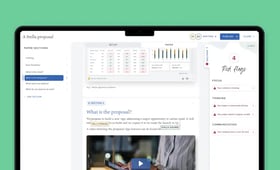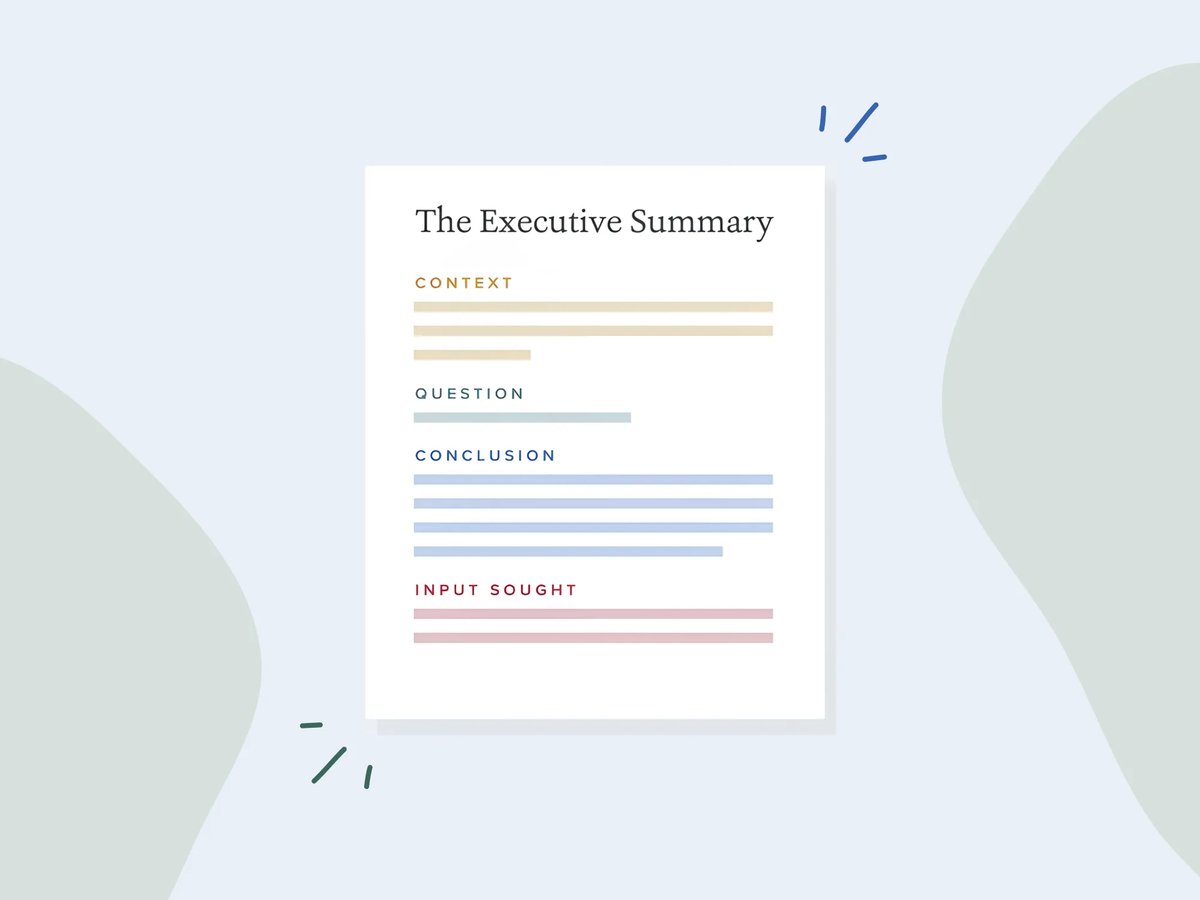“I feel like I’m joining the middle of a conversation.”
It’s probably the last thing you’ll want to hear from a director reading your board report, but it’s one of the most frequent pieces of feedback we hear from board members. No matter your level of experience, it’s easy to make the mistake of writing an executive summary that simply “sets the scene” and does very little else. But a good executive summary has the power to do so much more than that.
A well-written executive summary will bring everyone up to speed, signpost your key points and recommendations, lead into a robust report, and ultimately, make a strong impression on the board. The good news is, there’s a foolproof formula for getting this right — all on one side of A4. It’s called CQC (“Context, Question, Conclusion”), and here’s how it works.
What’s an executive summary — and what isn’t?
The executive summary is the sauce of your report. It exists to bind everything together and serve a flavour of your board paper, in one quick spoonful, to a time-poor audience that hasn’t yet decided whether it should start digging into the full report. It’s there to give your readers a sense of what your key messages are, why it all matters, and why they should read on.
But the executive summary isn’t the meat of your dish. The unpacking of those key messages, or the breakdown of the data that support your analysis and recommendations, should be dealt with in the body of your report — alongside everything that requires any amount of serious chewing.
What steps should you follow when writing an executive summary?
1. Give some context
Start by outlining how your report links to the bigger picture — for example, your organisation’s growth targets or brand strategy. Beginning your executive summary with an uncontroversial statement of fact, will help get the reader nodding along and on the same page as you. It’s also worth explaining the trigger for your report — why is this coming to the board now? Is this a “business as usual” update, or has there been an external stimulus?
Keep this section to a few short sentences that outline the “why, and why now” element of your report. You’ll have room to dive into the details in the report itself.
A concise cover sheet should set out the key issues, the points of contention, and the reason for the paper being included. This helps ensure the board doesn’t get drawn into the weeds of the details or tempted into oversight.”
Jane Hanson, Chair, Reclaim Fund
2. Focus your questions
Next, outline which questions the report will answer. Your best bet is to keep the number of questions between three and five. Research found that the human mind can only retain about five ideas at once — and you don’t want to risk overloading your directors.
These questions should be mutually exclusive — that is, the answers that they prompt should fit into discrete subsections of your report without overlapping. And they should lead to answers that provide all of the information, both good and bad, and present an accurate picture to the board. This principle is called MECE (“Mutually Exclusive, Collectively Exhaustive”). It ensures nothing is muddled and nothing is missing.
Reports have a natural tendency to hide the warts. That’s not just counterproductive but also a fundamental misunderstanding of what the board does. We need the full picture to do our job and support you to find solutions.”
Lynne Berry CBE, Chair, Human Tissue Authority
3. Share your conclusions
And now, it’s time to answer each of your questions, one at a time, with a short conclusion. It may feel strange to give away the ending up front, but your board members don’t want to be sifting for answers. After all, they’ve deemed you the subject matter expert in this area — you’re best placed to analyse the information.
The author knows far more about the topic than you ever will — so, why do subject-matter experts put the burden on the reader?”
Lord Victor Adebowale, Chair and Co-Founder, Visionable
4. Outline any input received and input sought
Finally, if appropriate, mention the inputs to your report or project, whether it’s from a colleague, a department or an external expert. And think carefully about what kind of input you want to get back from board members once they have read your report. Do you want specific advice, do you need them to make or approve a decision, or is the report just for their information?
Papers need to be very clear — why exactly is the board seeing this? Is this for information only, or are you expecting a decision from me?”
Alison Munro, Chair, TfL’s Independent Investment Programme Advisory Group
What does an example of a good executive summary look like?
So, what does that look like in practice? Here’s an example of the executive summary that a report author at one fictitious company, Globocorp, would include at the start of a paper informing the Senior Leadership Team of changes to the organisation’s reporting processes:
Globocorp’s new approach to reporting
Context
Our recent board effectiveness review highlighted the need to improve the quality of our board packs. This paper sets out what will change from the March SLT meeting onwards and what we need from you to make it a success.
Questions this paper addresses
- What is the new approach to reporting and timeframes?
- What are the benefits of doing this?
- As a member of the board, what do I have to do?
Conclusions
- We are introducing a new narrative format (details overleaf). We’ll upskill management by deploying:
- Workshop and coaching (this month).
- Video-based learning (ongoing).
- A feedback loop (post the SLT’s March meeting).
- The new way of reporting will be embedded at scale, with the following benefits:
- Decision-making: short, insightful papers, driving faster, smarter decisions.
- Accountability: high-quality reporting demonstrating a culture of ownership of decisions and their consequences.
- Time saving: writing long reports takes valuable time away from you and your teams at an estimated cost of c.£1m p.a. Time saved is time redirected to driving Globocorp forward.
- Your advocacy is critical to success. You will either be a sponsor, author, or commissioner of reports. In each of these roles, you play an important part:
- Brief: agree on the questions to ensure internal stakeholders are aligned at the outset. This reduces redrafting.
- Review your paper: check the facts, inject judgment, and be clear about your “ask”. It will help you get value back from the SLT.
- Attend a workshop: learn the principles of effective reporting. Lead by example through your own mastery.
- Advocate: great communication builds the board’s confidence in you and your team. With your leadership, we are confident in supporting a change in behaviour that lasts.
Input sought
- Do you have any questions or concerns regarding the approach?
- Do we have your unwavering support to deploy this initiative in your team?
Some tips to keep in mind:
- In your Context, be sure to mention the trigger (“Our recent board effectiveness review highlighted…”), and answer the “Why now?” question (“What will change from the March board meeting onwards…”).
- Then, in your Questions, list not the questions you’re most interested in, but those most likely to be on your forum’s mind. Keep them to five or fewer, and use them to underpin the structure of your report.
- For your Conclusions, be sure to answer the “So What?” by adding insight (“drive faster decisions”, “£1m p.a. saved”…), not just facts. Edit ruthlessly to keep everything under one page, and use simple language, writing as you would speak.
- Lastly, in your Input Sought, get value back by thinking about how your forum could add creativity, bring an external perspective, draw on its members’ experience, or help you get a clearer forward look. Use your readers to spot what you may be missing.
How do you start writing better executive summaries — and papers?
Get your free executive summary template
With the CQC recipe, you’ll write a winning report that not only engages directors on the issues you care about but also builds your credibility with your board — and you can download our free template that gives you everything you need to put this into practice:
Add that secret sauce to every report
Looking for a tool that automates the process, so you can go beyond templates and add that secret sauce to every report? Have a look at Report Writer, our AI-powered management reporting software. It can help you draft best practice executive summaries — as well as high quality reports — in an instant.
With Report Writer, you can go from blank page to ready-to-share paper in a blink, with the help of AI built on 20 years of report writing expertise.
See report writer


